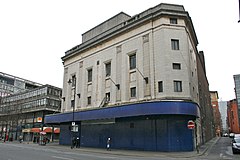Landmark, Manchester
| Odeon Cinema, Manchester | |
|---|---|

Odeon Cinema in 2009
|
|
| General information | |
| Type | Cinema |
| Location | Manchester, England |
| Coordinates | 53°28′37.34″N 2°14′33.72″W / 53.4770389°N 2.2427000°WCoordinates: 53°28′37.34″N 2°14′33.72″W / 53.4770389°N 2.2427000°W |
| Opening | October 1930 |
| Design and construction | |
| Developer | F. Verity and S. Beverley |
The Odeon Cinema, Manchester (originally known as the Paramount Theatre or the Paramount Cinema) was a former Odeon Cinema located on Oxford Street, Manchester, England. It was close to St. Peter’s Square, within the Civic Quarter of Manchester city centre. It was demolished in April 2017, to be replaced by Landmark, a 14-storey office building, as part of a major transformation of the area.
The location of the theatre had originally been developed towards the end of the 18th century; by the 1930s the site had been fully developed, featuring a mix of commercial and residential properties. By the start of the 20th century, the site was used entirely for commercial purposes, and it featured two pubs. The site was cleared by 1930 for the construction of the Paramount Theatre.
The Paramount Theatre on Oxford Street, Manchester, opened on 6 October 1930, showing The Love Parade, and featuring a variety show on stage. The theatre was built for the Paramount Film Company of America, and was designed by Frank Verity and S. Beverley (now known as Verity & Beverley), who had also built the Plaza Theatre in London. It was one of 50 proposed Paramount Theatres, and was one of the first open, and the first in the UK to bear the company's name; others included Paramount Leeds, Paramount Newcastle upon Tyne, Paramount Glasgow, Paramount Liverpool, Paramount Birmingham and Paramount, Tottenham Court Road, London.
A single-screen cinema, it was capable of seating 2,920 people on two levels (the Stalls and the Balcony), and the building also contained a fully equipped stage, a fly tower, dressing rooms, an orchestra pit, an organ and a cafe. The cinema was designed to operate in the cine-variety era; it was mostly used to show films (such as those featuring Maurice Chevalier and Jeanette MacDonald) but it also put on live stage shows (including those by Francis A Mangan, which were accompanied by a full orchestra). It was purchased in November 1939 by Oscar Deutsch as part of the Odeon Theatres Ltd, and was renamed as the Odeon in 1940. It became a Rank cinema in 1941. Its piano lounge subsequently hosted Bruce Forsyth among others.
...
Wikipedia
